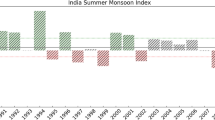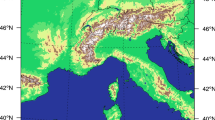Abstract
By use of a three-dimensional compressible non-hydrostatic convective cloud model with detailed microphysics featuring spectral bins of cloud condensation nuclei (CCN), liquid droplets, ice crystals, snow and graupel particles, the spatial and temporal distributions of hydrometeors in a supercell observed by the (Severe Thunderstorm Electrification and Precipitation Study) STEPS triple-radar network are simulated and analyzed. The bin model is also employed to study the effect of CCN concentration on the evolution characteristics of the supercell. It is found that the CCN concentration not only affects the concentration and spectral distribution of water droplets, but also influences the characteristics of ice crystals and graupel particles. With a larger number of CCN, more water droplets and ice crystals are produced and the growth of graupel is restrained. With a small quantity of CCN the production of large size water droplets are promoted by initially small concentrations of water droplets and ice crystals, leading to earlier formation of small size graupel and restraining the recycling growth of graupel, and thus inhibiting the formation of large size graupel (or small size hail). It can be concluded that both the macroscopic airflow and microphysical processes influence the formation and growth of large size graupel (or small size hail). In regions with heavy pollution, a high concentration of CCN may restrain the formation of graupel and hail, and in extremely clean regions, excessively low concentrations of CCN may also limit the formation of large size graupel (hail).
Similar content being viewed by others
References
Browning, K. A., 1964: Airflow and precipitation trajectories within several local storms which travel to the right of the winds. J. Atmos. Sci., 21, 634–639.
Flossmann, A. I., W. D. Hall, and H. R. Pruppacher, 1985: A theoretical study of the wet removal of atmospheric pollutants. Part I: The redistribution of aerosol particles captured through nucleation and impaction scavenging by growing cloud drops. J. Atmos. Sci., 42, 583–606.
Guo, X. L., M. Y. Huang, Y. C. Hong, H. Xiao, and L. Zhou, 2001a: A study of three-dimensional hailcategory hailstorm model Part I: Model description and the mechanism of hail recirculation growth. Chinese J. Atmos. Sci., 25, 707–720. (in Chinese)
Guo, X. L., M. Y. Huang, Y. C. Hong, H. Xiao, and L. Zhou, 2001b: A study of three-dimensional hailcategory hailstorm model Part II: Characteristics of hail-category size distribution. Chinese J. Atmos. Sci., 25, 856–864. (in Chinese)
Khain, A. P., D. Rosenfeld, and I. L. Sednev, 1993: Coastal effects in the Eastern Mediterranean as seen from experiments using a cloud ensemble model with a detailed description of warm and ice microphysical processes. Atmos. Res., 30, 295–319.
Khain, A. P., I. Sednev, and V. Khvorostyanov, 1996: Simulation of coastal circulation in the Eastern Mediterranean using a spectral microphysics cloud ensemble model. J. Climate, 9, 3298–3316.
Khvorostyanov, V. I., A. P. Khain, and E. L. Kogteva, 1989: A two-dimensional non-stationary microphysical model of a three phase convective cloud and evaluation of the effects of seeding by crystallizing reagent. Soviet Meteorology Hydrology, 5, 33–45.
Kong, F. Y., 1991: Three-dimensional numerical simulations of hailstorms. Ph. D. dissertation, Institute of Atmospheric Physics, Chinese Academy of Sciences, 155pp. (in Chinese)
Kong, F. Y., M. Y. Huang, and H. Y. Xu, 1990: Numerical simulation of ice microphysical process of convective cloud, Part I: Construction of cloud and the parameterization of ice cloud processes. Chinese J. Atmos. Sci., 14, 441–453. (in Chinese)
Kuhlman, K.M., C. L. Ziegler, E. R. Mansell, D. R. Macgorman, and J. M. Straka, 2006: Numerically simulated electrification and lighting of the 29 June 2000 STEPS supercell storm. Mon. Wea. Rev., 134, 2734–2757.
Liu, Q., and Y. Kogan, 1998: Large eddy simulations of cloud processing of small size aerosols in marine stratocumulus. Preprints, Conf on Cloud Physics, Everett, WA, Amer. Meteor. Soc., 329–332.
Liu, X. L., 2007: Research on cloud model with spectral bin microphysics. Ph. D. dissertation, Nanjing University of Information Science and Technology, 123pp. (in Chinese)
Liu, X. L., and S. J. Niu, 2007: Development of 3-D convective cloud model based on spectral bin microphysics. Journal of Nanjing Institute of Meteorology, 30, 617–622. (in Chinese)
Liu, X. L., and S. J. Niu, 2009: Numerical simulation on the evolution of cloud particles in 3-Dconvective cloud. Science in China (D), 52, 1195–1206, doi: 10.1007/s11430-009-0112-1.
Ovtchinnikov, M., and Y. L. Kogan, 2000: An investigation of ice production mechanisms in small cumuliform clouds using a 3D model with explicit microphysics, Part I: Model description. J. Atmos. Sci., 57, 2989–3003.
Ovtchinnikov, M., Y. L. Kogan, and A. M. Blyth, 2000: An investigation of ice production mechanisms in small cumuliform clouds using a 3D cloud model with explicit microphysics. Part II: Case study of New Mexico cumulus clouds. J. Atmos. Sci., 57, 3004–3021.
Rasmussen, R.M., I. Geresdi, G. Thompson, K. Manning, and E. Karplus, 2002: Freezing drizzle formation in stably stratified layer clouds: The role of radiative cooling of cloud droplets, cloud condensational nuclei, and ice initiation. J. Atmos. Sci., 59, 837–860.
Reisin, T., Z. Levin, and S. Tzvion, 1996a: Rain production in convective clouds as simulated in an axisymmetric model with detailed microphysics. Part II: Effects of varying drops and ice initiation. J. Atmos. Sci., 53, 1815–1837.
Reisin, T, Z. Levin, and S. Tzvion, 1996b: Rain production in convective clouds as simulated in an axisymmetric model with detailed microphysics. Part I: Description of the model. J. Atmos. Sci., 53, 497–519.
Sun, J. Z., 2005: Initialization and Numerical Forecasting of a Supercell Storm Observed during STEPS. Mon. Wea. Rev., 133, 793–813.
Takahashi, T., 1976: Hail in an axisymmetric cloud model. J. Atmos. Sci., 33, 1579–1601.
Tessendorf, S. A., L. J. Miller, K. C. Wiens, and S. A. Rutledge, 2005: The 29 June 2000 supercell observed during STEPS. Part I: Kinematics and microphysics. J. Atmos. Sci., 62, 4127–4150.
Tzivion, S., G. Feingold, and Z. Levin, 1989: The evolution of raindrop spectra. Part II: Collisional collection/break and evaporation in a rainshaft. J. Atmos. Sci., 46, 3312–3327.
Xiao, H., H. Y. Xu, and M. Y. Huang, 1988a: Numerical simulation on the formation of cloud drop spectrum in cumulus. Part I: The function of the spectra and concentration of salt. Chinese J. Atmos. Sci., 12, 121–130. (in Chinese)
Xiao, H., H. Y. Xu, and M. Y. Huang, 1988b: Numerical simulation on the formation of cloud drop spectrum in cumulus. Part II: The function of coalescence processes and atmospheric stratification. Chinese J. Atmos. Sci., 12, 312–319. (in Chinese)
Xu, H. B., 1999: Some questions in studying the evolution of size distribution spectrum of hydrometeor particles. Acta Meteorologica Sinica, 57, 450–460. (in Chinese)
Yin, Y., Z. Levin, T. Reisin, and S. Tzivion, 2000: Seeding convective clouds with hygroscopic flares: Numerical simulations using a cloud model with detailed microphysics. J. Appl. Meteor., 39, 1460–1472.
Zhao, S. X., H. B. Xu, and G. Deli, 2004: Numerical simulation of microphysical character of convective cloud precipitation in upper reach of yellow river. Plateau Meteorology, 23, 495–500. (in Chinese)
Author information
Authors and Affiliations
Corresponding author
Rights and permissions
About this article
Cite this article
Liu, X., Niu, S. Numerical simulation of macro- and micro-structures of intense convective clouds with a spectral bin microphysics model. Adv. Atmos. Sci. 27, 1078–1088 (2010). https://doi.org/10.1007/s00376-010-8088-5
Received:
Revised:
Published:
Issue Date:
DOI: https://doi.org/10.1007/s00376-010-8088-5




